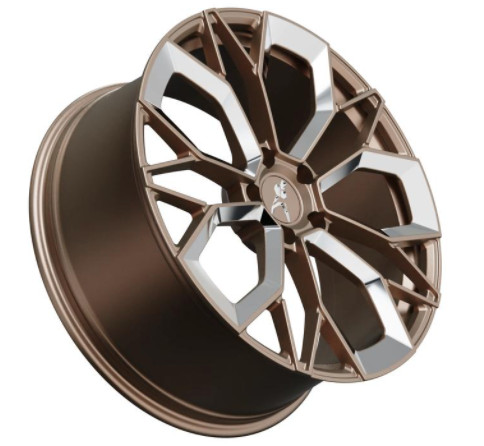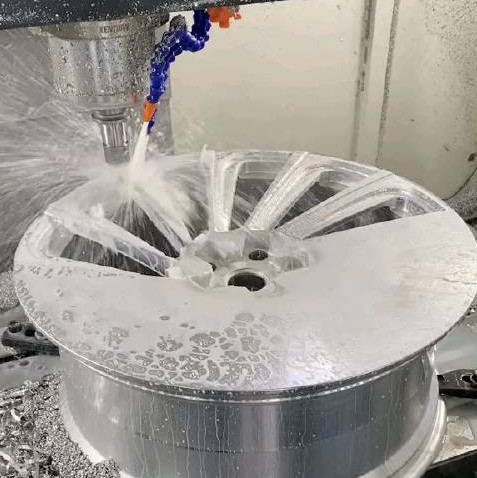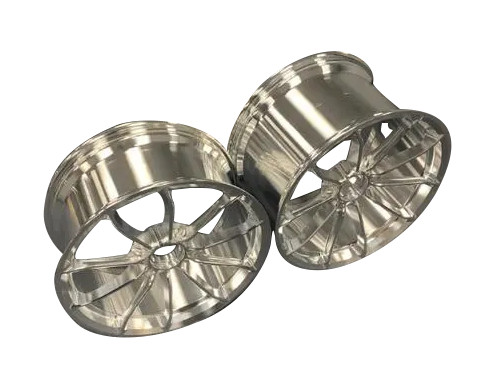The automotive wheel hub, a critical component of vehicles, supports the tire and ensures safety, efficiency, and aesthetic appeal. This article focuses on the forging process for deep groove rims, a widely used structure in passenger cars, emphasizing its manufacturing techniques, material properties, and equipment. The forging process offers superior performance and cost advantages over traditional methods like casting. Below, we explore the materials, structural characteristics, and detailed steps of the forging process for deep groove rims, providing a systematic and technical overview of the production workflow.
Wheel Hub Structure and Materials
Wheel hubs consist of two primary components: the rim and the spoke. These can be integral, permanently connected, or detachable, depending on the design. The rim, which supports the tire, varies in structure, with deep groove and flat-bottom rims being the most common. Deep groove rims, characterized by a concave cross-section and a 4°–6° inward tilt at the shoulder, are lightweight, rigid, and suitable for small, elastic tires used in passenger cars and light off-road vehicles. Flat-bottom rims, in contrast, are typically used in heavy-duty trucks due to their robust structure.
Material selection significantly impacts wheel hub performance. Steel and aluminum alloy are the primary materials. Steel hubs offer high strength but are heavier, making them ideal for large trucks. Aluminum alloy hubs, approximately two-thirds lighter than steel, provide better heat dissipation and align with low-carbon design principles. Common aluminum alloys, such as T6061, offer excellent forgeability, enabling thinner walls and higher strength compared to steel.
| Material | Advantages | Applications |
|---|---|---|
| Steel | High strength, durable | Large trucks, heavy-duty vehicles |
| Aluminum Alloy (e.g., T6061) | Lightweight, good heat dissipation, forgeable | Passenger cars, light off-road vehicles |

Common Wheel Hub Manufacturing Methods
Aluminum alloy wheel hubs are produced using various methods, including casting, forging, stamping, and spinning. In many regions, low-pressure casting remains dominant due to its established infrastructure. However, forging combined with spinning has gained traction for its ability to produce high-strength, lightweight hubs with fewer defects. The forging-spinning process involves pre-forging a blank, die forging, spinning, heat treatment, and CNC machining. This method minimizes wall thickness while maintaining structural integrity, addressing common casting issues like shrinkage and porosity, particularly in thin-walled components.
Casting methods include gravity casting, low-pressure casting, counter-pressure casting, and squeeze casting. Low-pressure casting is the most prevalent, involving metal melting, mold preparation, pouring, and cooling. However, it requires extensive equipment and multiple steps, increasing the likelihood of defects. Forging, by contrast, enhances material properties through controlled deformation, resulting in superior mechanical performance.
Characteristics of Deep Groove Rim Processing
Deep groove rims, typically used in permanently connected wheel hubs, are produced separately from spokes and joined via welding. Their thin-walled, sleeve-like structure makes them suitable for pressure-based processing using sheet metal. The forging process for deep groove rims involves precise material selection and controlled deformation to achieve the desired shape and strength. Spokes, often manufactured using spinning and machining, complement the rim’s production. Modern manufacturing integrates automation and information to enhance efficiency and precision, ensuring consistent quality across high-volume production.
The process prioritizes dimensional accuracy, structural integrity, and compatibility with tire installation. By leveraging advanced equipment, manufacturers can reduce labor intensity and improve repeatability, aligning with industry demands for lightweight, high-performance components.
Forging Process for Deep Groove Rims
The forging process for deep groove rims transforms sheet metal into a finished component through a series of controlled steps. Each stage is designed to achieve specific dimensional and mechanical properties, ensuring the rim meets stringent automotive standards. Below is a detailed breakdown of the process.
Coiling
The process begins with sheet metal preparation. High-precision sheet metal, typically aluminum alloy or specialized steel, is uncoiled, flattened, and cut to size. Acid pickling removes surface impurities, ensuring a clean workpiece. The sheet is then fed into an automatic coiling machine, which deforms it into a cylindrical shape resembling the rim’s structure. This initial coiling produces an open cylinder, which is not yet fully closed.
Welding
The open cylinder is welded to form a closed structure using flash butt welding. This technique heats the contact points of the sheet’s edges using electrical resistance, melting them without additional filler material. Once the metal reaches the target temperature, a forging force is applied to bond the surfaces at the atomic level. To minimize errors, a pre-welding flattening step ensures edge alignment. Post-welding, a slag removal machine eliminates weld imperfections, followed by pressing and rolling to align the weld seam with the base material. Excess material at the weld ends is trimmed using a cutting mechanism.
Flaring
The welded cylinder has a uniform diameter, but deep groove rims require a larger outer diameter and a narrower central section. Flaring expands both ends of the cylinder into a trumpet-like shape using a flaring machine. This step ensures reliable positioning during subsequent rolling and prevents cracking due to excessive deformation. Different rim diameters require specific flaring molds, which are swapped as needed.
Rolling
Rolling, a form of spinning, shapes the flared cylinder into the final rim profile. The process involves three rolling stages using a rolling machine with upper and lower molds. The first stage pre-forms the deep groove transition, ensuring accurate centering. The second stage refines the shape, maintaining the groove’s base while achieving the tire bead seat dimensions. The third stage corrects the surface profile, leaving minimal radial machining allowance while meeting all other design dimensions. Rolling ensures high coaxiality, cylindricity, and dimensional accuracy.
Expansion and Finishing
After rolling, the rim undergoes cold rolling to remove burrs and smooth transitions at the edges. Expansion finishing, performed using an expansion mold, precisely adjusts the rim’s diameter to meet design specifications. This step ensures dimensional consistency and prepares the rim for final assembly.
Additional Processing
Post-forming, the rim undergoes quality checks, including airtightness testing. Gas sensors detect leaks, identifying defects and their locations. Rims meeting sealing requirements proceed to additional operations, such as drilling valve holes, based on specific design needs.
Press-Fit Welding
The finished rim is assembled with the spoke using a press-fit machine, which aligns the components with precise offset values. A rim-spoke welding machine then joins the parts into a single unit. The welded hub undergoes rigorous inspection to ensure minimal runout, a critical parameter affecting wheel performance. Qualified hubs complete the forging process.

Technical Advantages of Forging
Forging deep groove rims offers distinct advantages over casting. The process enhances material properties by refining grain structure, improving strength, and reducing defects. For materials like T6061 aluminum or specialized steel, forging allows thinner walls without compromising rigidity, resulting in lighter hubs. Compared to casting followed by machining, forging eliminates chip waste, reduces processing time, and conserves material. The use of automated equipment integrating hydraulic, pneumatic, and control technologies streamlines production, lowers energy consumption, and reduces labor intensity.
| Process | Advantages | Equipment Used |
|---|---|---|
| Forging | High strength, lightweight, no chip waste | Coiling machine, flaring machine, rolling machine |
| Casting | Established, versatile | Casting molds, furnaces |
Conclusion
The forging process for deep groove rims combines precision, efficiency, and material optimization to produce high-performance automotive wheel hubs. By leveraging advanced equipment and controlled deformation, manufacturers achieve lightweight, strong, and precise components that meet modern automotive demands. The integration of automation and advanced material processing ensures consistent quality and cost-effectiveness, making forging a preferred method for deep groove rim production.
